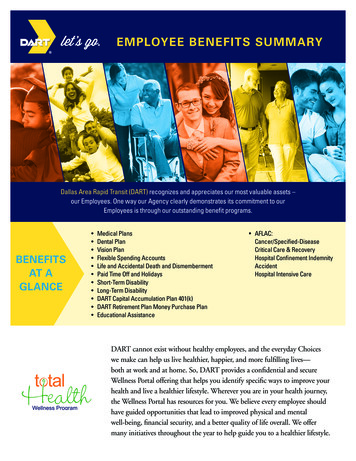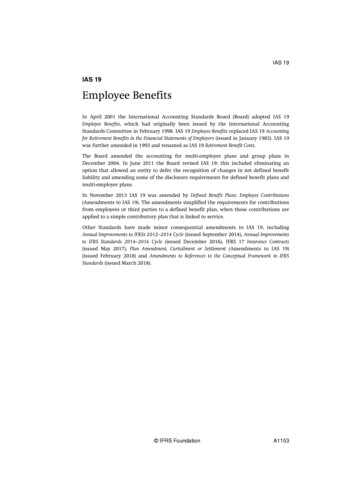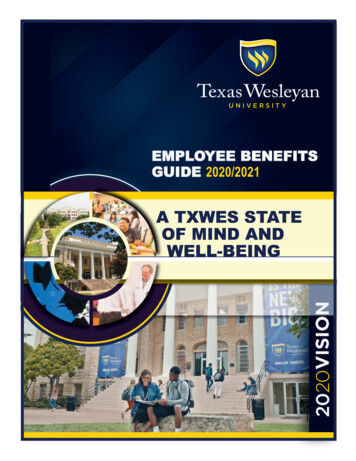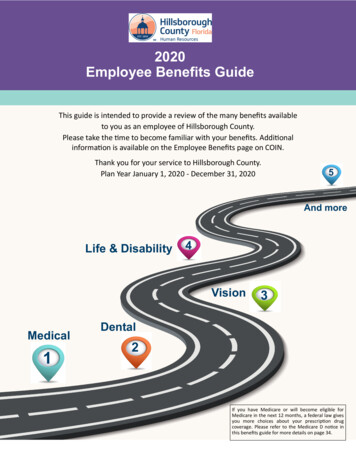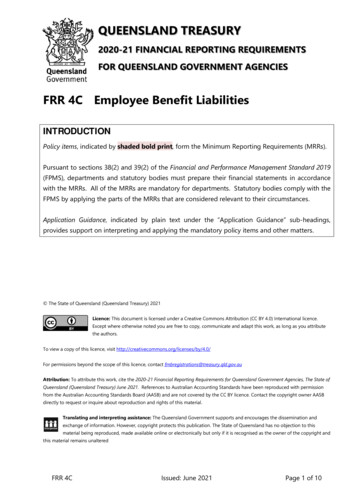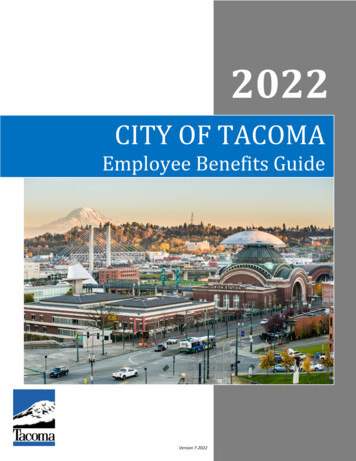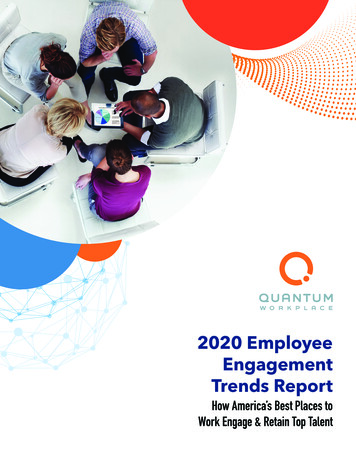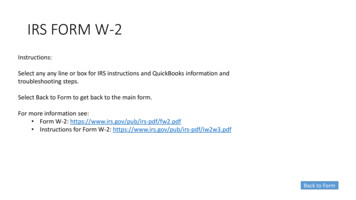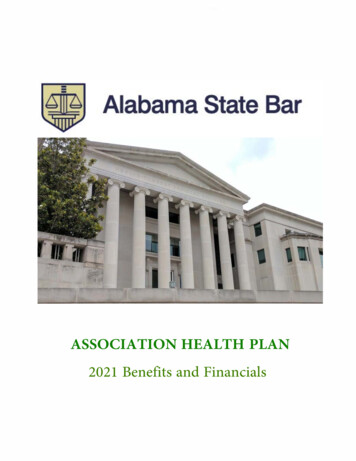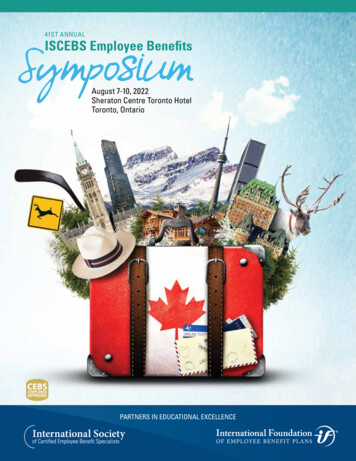
Transcription
41ST ANNUALISCEBS Employee BenefitsAugust 7-10, 2022Sheraton Centre Toronto HotelToronto, OntarioCOMPOMPLL IANCEAPPROVEDPARTNERS IN EDUCATIONAL EXCELLENCE
What Can You Expect at the Symposium?Previous attendees said it best:The Symposium is apremier learning event. Asan investment of time andmoney, it is exceptional forthe current and future trendcontent delivered by topnotch speakers.I value the networking withthose who “get” me and myjob, as well as sessions thatdig deep without spending thefirst 15 minutes defining termsand concepts for those whodon’t work in benefits.I always learn somethinginteresting, new oractionable at thesessions. I appreciatethe opportunity to learnnew things outside myarea of expertise.Who Attends:The Symposium welcomes benefits and compensationprofessionals looking for timely content and actionable takeaways.Attendees represent corporations, consulting firms, health careorganizations, hospitals, banks, insurance companies, investmentand administration firms, jointly trusteed and public employeebenefit plans, law firms and other organizations in the employeebenefits space.Registration Is Open to: ISCEBS members CEBS , GBA, RPA and CMS designees CEBS participants I nternational Foundation corporate benefitsprofessional members Professionals working in the employee benefits space.Register Now!Special guest registration (a 200 savings) andunemployed rates are available; see page 21 for details.Use the formon page 22Online atwww.iscebs.orgCEBS Compliance ApprovedCOMPOMPLL IANCEAPPROVED2This program qualifies for up to 19 CEBS Compliance credits.Visit www.cebs.org/compliance for more information.41ST ANNUAL ISCEBS SYMPOSIUM AUGUST 7-10, 2022Call(262) 786-8771
The Symposium Is Your Benefits CommunityLet’s learn together again! As we work toward the “next normal,” it’s time to reconvene for a look back and to look ahead at the criticalbenefits and workplace topics that continue to shape and define our world. The pandemic, the Great Resignation, and a growingspotlight on diversity and inclusion have given us a new lens through which to consider the how, where and why we work as well asthe role of benefits in an evolving workforce.Attend the Symposium and learn from some of the best in the industry how your benefits colleagues are addressing these challenges,along with the health care and retirement benefit topics vital to your plans’ success and your career growth.The Symposium’s education agenda is curated by your ISCEBS peers in partnership with the International Foundation Corporate Board. You’llbe empowered with valuable insights and knowledge to best position your expertise for the challenges of today and the trends of tomorrow.Attend the event where everyone gets what you do!Ryan Siemers, CEBS2022 ISCEBS PresidentPrincipalAegis Risk LLCAlexandria, VirginiaMary Takagi, CEBS2022 InternationalFoundation CorporateBoard ChairDirector, GlobalBenefits andTotal RewardsSun ChemicalCorporationParsippany, New JerseyMichelle Oram, CEBS2022 ISCEBSVice PresidentProduct Owner,Financial WellnessManulifeWaterloo, OntarioMauro Canori2022 InternationalFoundation CorporateBoard Vice ChairHR LeaderWuXi AdvancedTherapiesPhiladelphia,PennsylvaniaMONDAY, AUGUST 8HEALTH CARE8:00-9:15 a.m.GENERALCANADIANWelcome and Keynote : Building the Postpandemic Future of Work9:30-10:30 a.m.11:00 a.m.12:00 noonRETIREMENTU.S. Legislative UpdateThe Cost of Delayed Cancer Care: How toCreate a Benefit to Give Employees the RightCancer Care Discover the impact of delayed or missed cancercare through outcomes data. Review case studies on the wrong vs. the rightdiagnosis and treatment. Learn about the right identification and referralstream within your benefit design.12:00 noon1:30 p.m.Canada Legal and Legislative UpdateStatutory and Regulatory Outlookfor Retirement Plans Overview of statutory developments for retirement plans Tips for ERISA fiduciaries based on DOL regulations and other guidance Tips for complying with new compliance rulesfrom the IRSWA Cares Fund: Legislating Long-Term Care An understanding of Washington state’s longterm care (LTC) program and how it compares toLTC insurance products Insight into the opt-out requirements for employees to apply for exemption from the tax The various legal issues that the law may faceUnderstanding Gene Therapy and Its Impact onPrivate Drug Plans Gene therapy is different than traditional drugsand can eliminate a lifetime of other expensivehealth care costs. Gene therapy is challenging to reimburse dueto the large upfront cost with much longer termbenefits. Explore possible opportunities to consideralternative pooling and funding models to addresssome of these challenges.Lunch and Roundtable Discussions1:30-2:30 p.m.Real Health Care Improvement That EmbracesSocial Determinants Learn the impact of social determinants and howthey influence the health of the population. Explore how a nonconventional approach ofproviding the “right” care vs. health care hasimpacted health and influenced plan spend. Be able to analyze your plan spend and population needs to influence the root cause of diseaseand demand on the health care system.Multiple Employer Arrangements:Evolution or Revolution? The differences between multiple employer plans,pooled employer plans, employer aggregationprograms and defined contribution groups Different approaches and offers available in themarketplace and emerging best practices The benefits of joining a multiple employer solution, including risk mitigation for the plan sponsorSeven Things for Benefits Professionals toAvoid During HR System Implementation Preparing for a new HR system Identifying items that are commonly overlooked insystem implementations Specific pitfalls common to benefits professionalsEnvironmental, Social and Governance (ESG)Investing in Pension Plans How to articulate, implement and monitor anESG strategy ESG ratings and greenwashing: What to look for Emerging ESG and sustainability trends2:45-3:45 p.m.Don’t Be Surprised by the No Surprises Act Which group health plans are subject to theNo Surprises Act (NSA) What benefits are no longer allowedout-of-network cost Defining “recognized amount” for services anddispute resolution optionsEvolution of the DC Plan Investment Menu Should you refresh your investment policystatement? Tips and best practices for retirement plans What new investment options are available andhow to assess themMoneyball: Strategic Frameworkfor Compensation and Benefits The key tenets of a total rewards program How to design and communicate effectively forgenerational needs of employee populations Executive buy-in and participation, defining victory for each stakeholderWatch Your Language: Are WordsUnintentionally Harming Your DEI Efforts? W hy inclusive language matters Origins of some commonly used terms T ips on how to write inclusive communications fora diverse audience4:00-5:00 p.m.Recovery-Friendly Strategies to AddressSubstance Use Disorders in the Workplace Understand how to overcome stigma to createinclusive environments for those overcoming SUDs. Apply culturally relevant techniques to create inclusivity and belonging among those in recovery. Recognize signs of workers in recovery and learnhow to intervene with evidence-based bestpractice approaches.A Look at the New Long-Term Part-TimeEmployees Rules Which plan designs will be impacted by the newrules and when? Plan design options to consider What data to collect and what questions to asknow to prepareTotal Rewards: Essential to a Total Inclusion Solution Understand how total rewards do or do not align with the organization’s overall inclusion strategy. Evaluate whether the total rewards strategy is currently a barrier to entry or an on-ramp to new anddiverse talent. Explore total rewards’ role in the employee life cycle and inclusive succession planning.(262) 786-8771 www.iscebs.org3
TUESDAY, AUGUST 9RETIREMENTHEALTH CARE8:00-8:30 a.m.GENERALPresident’s Report8:30-9:30 a.m.The Future of Retirement: How Plan Sponsorsand Advisors Can Improve the Plan MemberExperience Through Longevity Lifestyle Design Why a one-size-fits-all approach to retirementplanning no longer makes sense Taking a design approach to retirement (longevity)lifestyle A standardized step-by-step process for longevitylife designU.S. Legal Update10:00-11:00 a.m.CANADIANMental Health Parity: Updates on the New Rules Mental health parity NQTLs—Basic requirements DOL initiative and focus on NQTL comparativeanalysis in light of CAA requirements How to prepare for a DOL inquiry and working withcarriers to fashion a responseDOL Retirement Enforcement Update Current DOL enforcement results, trends andpriorities The six major fiduciary regulations that plan sponsors are facing Practical action steps to comply, document andprotect your plans and participantsFringe Benefits Taking Center Stage Various supplemental fringe benefits to addressareas not sufficiently covered by traditional offerings Why §213(d) medical expenses cannot be reimbursed (even on a taxable basis) outside the healthplan without establishing a specialty HRA The rise of the lifestyle spending account (LSA) andcompliance pitfalls to avoid triggering various grouphealth plan and tax lawsCybersecurity in a World of Remoteand Hybrid Work T ips and strategies to protect against ransomwareand other cyberattacks C urrent trends in privacy and networksecurity breaches Legislation and future trendsACA Reporting: From Uncertainty to IncreasedScrutiny Areas in your current process to revisit to ensuretimely and accurate forms The role that letters 226J (Employer Shared Responsibility Payment) may play in accuracy-relatedpenalties Summary chart of various deadlines and possiblepenaltiesWhat Is Your Data Telling You AboutParticipants’ Retirement Readiness? Detailed analytics to assess retirement readinessthroughout one’s career path Qualitative and analytic techniques that identifytrends and insights How to use data analytics to personalize eachsituationSmarter Benefit Choices Can ImproveRetirement Readiness The financial impact of health plan selections onboth current-year and future-year savings The motivations leading individuals to selectsuboptimal plans Opportunities to improve plan selection and overallfinancial wellness amongst participantsTransparency as a Retention Tool T he importance of considering transparency inhuman resources strategy T he transparency spectrum, understanding wherean organization is on the spectrum and how toachieve greater transparency A n overview of the various compliance requirements that involve disclosure of compensation andbenefits information1:30-2:30 p.m.ERISA Compliance: To Wrap or Not to Wrap How wrap plans can help satisfy the ERISA plandocument and SPD requirements Form 5500 filing requirements for wrap plans Best practices, penalties and pitfalls to avoid, andwhat plans can’t be includedFinancial Caregiving: Promoting Planning andResources to Help Employees The financial obstacles caregivers face planningtheir retirement and ways to include those issues infinancial wellness programs Programs and resources to assist caregivers inmanaging other people’s money Tools available from other networks and organizationsForensic Benefits—Assessing YourBenefit Department’s Compliance A process to review plan documents and policies Sample compliance documents A methodology to review rates and feesWhat We Know About Resilience andIts Application in Workplaces Resilience in context of workplaces T he value of investing in and developing a strategyfor resilience in the workplace R ecognizing quality programming and strategiesfor resilience2:45-3:45 p.m.Steering Participants to High-Performing Networks How to ensure high-quality care at the right time,place, price and outcome Using data mining utilization techniques to lead tosignificant cost savings and ROI How to steer more plan members to high-qualitysurgeries for nonemergent conditionsDoes Your Retirement Plan Reflect YourDEI Efforts? How to dig deeper into your data to find out howyour retirement plan is being used How to evaluate your communications and tools forclarity and inclusiveness What financial literacy and decision supportresources to focus onWellness and Financial Education SurveyResults: What’s Changing and What’s Working? Benchmarking data about the state of workplacewellness and financial education initiatives Through a longitudinal analysis, how these trendshave changed between 2008 and 2021 Case study evidence of these trends in actionWhy You Should Care If Your BenefitsAre Braggable Structuring a “braggable” benefit plan Better employee engagement and retention Costs and budget factors to consider4:00-5:00 p.m.High-Cost Claimants: Drivers and Emerging Trends Recent trends and drivers of HCCs How to use data and predictive analytics to addresschallenges of HCCs Solutions in the marketplace to help managefinancial and clinical risksLet’s Talk MentalHealth: FacilitatedDiscussionLegal Update Follow-UpLet’s Talk Canadian Benefits:Facilitated Discussion11:15 a.m.12:15 p.m.12:15-1:30 p.m.Lunch and Professional RecognitionLet’s Talk RetirementReadiness: FacilitatedDiscussionWEDNESDAY, AUGUST 10RETIREMENTHEALTH CARE8:00-9:00 a.m.9:30-10:30 a.m.4GENERALCANADIANKeynote: Economic Outlook in Today’s WorldGroup Health Plan Service ProviderCompensation Disclosure What are the new compensation disclosurerequirements? What should a plan sponsor do to determinecompensation “reasonableness”? How are group health plan services priced?Cybersecurity Is a Fiduciary Duty Monitoring how the recordkeeper/vendor uses youremployees’ data Knowing and documenting your organization’scybersecurity process/procedures Identifying what employee education is neededand availableGlobal Benefits: Challenges and Opportunities Global benefits are unique and require differentlevels of knowledge. Understand the tools and techniques of deliveringglobal benefits to provide comprehensive benefitsplans throughout the world. Establish strategic goals and objectives andformulate a unique benefit solution for each countrycovering TCNs, KLNs and local nationals.Innovations in DC Decumulation Options Learn how workforce needs are changing andwhy supporting members through retirement isessential. Explore fiduciary considerations for employerssupporting plan members in the transition toretirement. Understand trends and emerging decumulationoptions.10:45-11:45 a.m.Managing Specialty Pharmacy Costs How to clearly evaluate a PBM contract and pricingoffered for specialty drugs Specific steps to manage your current and futurespecialty drug spend Marketplace trendsAiming at the Wrong Target—What’s HoldingEmployers Back When It Comes to Older Workers? Regulatory changes needed for greater use offlexible employment/phased retirement Cost-effective benefits and policies designed tocapture productivity from talented, experiencedolder workers Identifying barriers in recruiting, selecting andretaining older workersDisaster Planning: Using Benefits toAlleviate the Impact How to use employee benefits to assist employeesduring disasters or emergencies How to use employee benefits to maintain or restartoperations during a disaster or emergency How to avoid inadvertent compliance issues withemployer plans during disasters or emergenciesHow Meaningful Employee Benefit Surveysand Focus Groups Drive Engagement Why learning what your plan members understand,think and feel can drive more value from yourexisting benefit plan Best practices to gain meaningful insights andactionable data from your plan members How employee surveys and focus groups can buildacceptance of new programs and changes12:00 noon1:00 p.m.Putting Virtual Care to the Test: Can It TrulyDeliver Integrated Care for Mind and Body? How to evaluate current solutions through the lensof point solution vs. integrated care What success metrics to expect The improvements an employee sees in their physical health when also treating their mental health,particularly for chronic conditionsUnderstanding Your Retirement Plan Fees The pitfalls of incomplete or incorrect benchmarking Evaluating investment costs in relation to fundperformance Working with your providers to determinereasonableness of fees or renegotiateThe Beat Goes On: The Continuing Drumbeat ofPaid Family and Medical Leave The structure and requirements of paid family andmedical leave laws Coordinating company leave and benefits policieswith statutory paid leave laws Developing a game plan for complying with multiplestate and federal PFML lawsThe Cost of Doing Nothing Different: Are YouManaging Absenteeism Effectively? Gain insight into how mental health’s growingand hidden costs can increase absenteeism andcontribute to lost time and productivity. Identify remedies organizations can take to increaseROI and tips for building an overarching total healthand wellness program. Learn how to diagnose your data, measure yourprogress and keep employees at work41ST ANNUAL ISCEBS SYMPOSIUM AUGUST 7-10, 2022
Sunday/MondaySUNDAY, AUGUST 7MONDAY, AUGUST 8 (CONT.)5:00-7:00 p.m.CEBS Conferment Ceremony11:00 a.m.-12:00 noon Concurrent Sessions The Cost of Delayed Cancer Care: How to Create aMONDAY, AUGUST 8Speakers: Cheryl Nienhuis, CEBS, Director, Complex Care Program,Mayo Clinic, Rochester, MinnesotaBenefit to Give Employees the Right Cancer Care(see page 18 for details)Brent Westra, Director, Complex Care Program, Mayo Clinic,Rochester, Minnesota8:00-9:15 a.m.Welcome and Keynote:Building the Postpandemic Future of WorkCancer cases have become more difficult and costly to treat due to advancement of the disease as individuals have delayed important cancerscreenings and timely care throughout the pandemic. Standard benefitdesigns are increasingly unable to overcome the challenges of delayedcancer screenings and care. By creating a benefit design with highquality providers, employers can provide enhanced benefits and accessto exactly the right cancer care to encourage the timely identificationand treatment of cancer.Speakers: R oselyn Feinsod, Principal, People Advisory Services, EY,New York, New YorkoDarryl Wright, National Lead, Talent and Future of Work, EY,Toronto, OntarioThe workplace and workforce are undergoing drastic change in realtime, at a pace accelerated by COVID and other factors. How, whereand even why we work have all been impacted. Employee benefitsunderpin so much of the employee-employer relationship, which putsbenefits professionals in a strong position to learn from and lead theway on these fundamental shifts. Join us for an insightful look at howfactors like COVID-19; a growing spotlight on diversity, equity and inclusion; talent recruitment and retention; remote and hybrid teams; andemployee resilience can help you build the workplace your employeeswant and need to bring their best each day.Takeaways Discover the impact of delayed or missed cancer care throughoutcomes data. Review case studies on the wrong vs. the right diagnosisand treatment. Learn about the right identification and referral stream within yourbenefit design.9:30-10:30 a.m. U.S. Legislative UpdateSpeaker: James Klein, President, American Benefits Council, Washington, D.C.Benefits legislation and regulation continue to impact plan sponsors, particularly in an election year. Who wins in November and their actions willshape benefits in 2022 and beyond. This session provides an informativeand comprehensive analysis on recent, pending and upcoming legislationactivities that will continue to shape your plan decisions.Canada Legal and Legislative UpdateSpeaker: A ndrea Boctor, Partner, Osler, Hoskin & Harcourt LLP,Toronto, OntarioThis session tees up 2½ days of Canadian benefits sessions with anoverview and analysis of legislation, regulatory activity and relevantlegal cases at the federal and provincial levels. Find out what theseactivities mean for your group, pension and other benefit plans. Statutory and Regulatory Outlook for Retirement PlansSpeaker: Steven Grieb, CEBS, Senior Compliance Counsel, Gallagher,Milwaukee, WisconsinGet an overview of proposed or enacted regulatory topics for qualifiedretirement plans, including DOL final regulations on fiduciary standardswhen selecting ESG investments; DOL proposed regulations relating tothe definition of “fiduciary” under ERISA; and any additional statutory, regulatory or other developments from the IRS, DOL and PBGC.This includes potential regulatory or statutory developments involvingneeded guidance for SECURE Act provisions and the Build Back Betterbill (should it pass).More speakers tobe announced soon!Visit www.iscebs.org/symposiumto see the most up-to-datespeaker information, or scan here.Health Retirement GeneralTakeaways Overview of statutory developments for retirement plans Tips for ERISA fiduciaries based on DOL regulations and other guidance Tips for complying with new compliance rules from the IRSCanadian(262) 786-8771 www.iscebs.org5
MondayMONDAY, AUGUST 8 (CONT.)MONDAY, AUGUST 8 (CONT.)11:00 a.m.-12:00 noon Concurrent Sessions (cont.) WA Cares Fund: Legislating Long-Term Care1:30-2:30 p.m. Speaker: S andra Wood, CEBS, Chief Benefits Consultant, The Benefits Academy, Seattle, WashingtonWashington is the first U.S. state to create a long-term care programfully funded through a payroll tax. Many other states are looking toward Washington for what lessons can be learned from their hardshipsas they formulate their own programs. We’ll review WA Cares Fund’seligibility parameters, benefits structure and provider requirements aswell as the initial tax rate and the allowance of exemptions from thetax. And since the law is being challenged from a few different sectors,an overview of an ERISA lawsuit, a citizen’s initiative and a cease-anddesist letter from Idaho will be discussed.Takeaways An understanding of Washington state’s LTC program and how itcompares to LTC insurance products Insight into the opt-out requirements for employees to apply forexemption from the tax The various legal issues that the law may face Understanding Gene Therapy andIts Impact on Private Drug PlansSpeaker: S uzanne Lepage, Private Health Plan Strategist, Suzanne LepageConsulting, St. George, OntarioScientific research continues to bring hope to patients, and theemerging, highly specialized discoveries in gene therapy are notableinnovations that could reshape the way certain diseases are managedand treated. Gene therapy targets the underlying cause of a geneticdisease and can cure—rather than just treat—complex medicalconditions. But what does it mean for benefits plan sponsors and forour health care system at large? This session will explore the risks andrewards of gene therapy: what it is, how it works, who needs the treatment and how it might fit into the Canadian health care system, bothoperationally and from a funding perspective.Takeaways Gene therapy is different than traditional drugs and can eliminate alifetime of other expensive health care costs. Gene therapy is challenging to reimburse due to the large upfrontcost with much longer term benefits. Explore possible opportunities to consider alternative pooling andfunding models to address some of these challenges.12:00 noon-1:30 p.m.Lunch and RoundtableDiscussionsSee pages 7 and 19 for details.Sponsored bySpeakers: Lisa J. Allen, CEBS, Director of Benefits, Goodwill Industries ofCentral Indiana, Indianapolis, IndianaMary Delaney, President, Vital Incite, Indianapolis, IndianaGoodwill of Central & Southern Indiana’s value statement includesidentifying gaps, evaluating opportunities and creating solutions thatadvance their mission of providing employment, creating self-sufficiencyand having a lasting impact that affects multiple generations. Goodwillemploys persons with significant social disparities that impact theirhealth, across 39 counties. In 2011, Goodwill started on a journey toprovide the right health plan services to help its people reach theirfullest potential. We’ll share how this ever-evolving program has keptGoodwill’s health plan more efficient than the average employer inthe U.S. but addressed things such as food insecurities, primary careaccess, mental health and basic household needs.Takeaways Learn the impact of social determinants and how they influence thehealth of the population. Explore how a nonconventional approach of providing the “right”care vs. health care has impacted health and influenced plan spend. Be able to analyze your plan spend and population needs to influencethe root cause of disease and demand on the health care system. ultiple Employer Arrangements:MEvolution or Revolution?Speaker: Virginia Brennan, CEBS, Head of ABA Retirement Funds andMultiple Employer Solutions, Voya Financial, Braintree,MassachusettsSince the passage of the SECURE Act, which allowed PEPs to becomeavailable, plans that aggregate employers—like PEPs, MEPs andemployer aggregation programs—continue to evolve and transformthe retirement plan landscape, reducing risk and providing anotherplan management option to plan sponsors. This session will highlightthe different roles involved with managing these plans, including plansponsor, recordkeeper, investment manager and pooled plan provider;benefits and considerations plan sponsors should take into accountwhen considering entering into a multiple employer plan arrangement;and the latest thought leadership around this quickly evolving plansolution.Takeaways The differences between multiple employer plans, pooled employerplans, employer aggregation programs and defined contributiongroups Different approaches and offers available in the marketplace andemerging best practices The benefits of joining a multiple employer solution, including riskmitigation for the plan sponsorHealth6Concurrent Sessions Real Health Care ImprovementThat Embraces Social Determinants41ST ANNUAL ISCEBS SYMPOSIUM RetirementAUGUST 7-10, 2022 GeneralCanadian
MondayMONDAY, AUGUST 8 (CONT.)MONDAY, AUGUST 8 (CONT.)1:30-2:30 p.m. Concurrent Sessions (cont.) Seven Things for Benefits Professionals2:45-3:45 p.m. Concurrent Sessions Don’t Be Surprised by the No Surprises Actto Avoid During HR System ImplementationSpeaker: Katherine Lacy-Wilson, CEBS, Employee Benefits ComplianceAttorney, USI Insurance Services, Bloomington, MinnesotaSpeaker: L isa Villalobos, CEBS, Owner, Workday HCM Consultant, AeolicConsulting, San Francisco, CaliforniaThe No Surprises Act (NSA) took effect this year, with additional guidance likely to follow. The normal processes for emergency services andsurprise billing will be drastically altered. Communications to participants will have to provide detailed guidance on what is no longersubject to balance billing vs. what still falls within that domain. Justas important, employers, carriers and third-party administrators mustunderstand their roles and disclosure requirements.Dive into a case study of a new HR system implementation projectthat had planning, a healthy budget, executive support and a strongteam. At go-live two years later, they were a little tired and very proudof their accomplishment, but it definitely wasn’t perfect. The benefitsteam had learned a few tough lessons through the process. Some ofthem were obvious (change management), but some were more subtle(selecting the right subject matter expert for the team). In this session,you’ll hear what they learned so that you can consider these lessonsduring your next system implementation.Takeaways Which group health plans are subject to the NSA What benefits are no longer allowed out-of-network cost Defining “recognized amount” for services and disputeresolution optionsTakeaways Preparing for a new HR system Identifying items that are commonly overlooked insystem implementations Specific pitfalls common to benefits professionalsEvolution of the DC Plan Investment MenuSpeaker: Michael Sheppard, Managing Partner, IronwoodDrive FinancialGroup, Milwaukee, Wisconsin Environmental, Social and Governance (ESG)Investing in Pension PlansLegislation like the SECURE Act and CARES Act has brought aboutinnovative changes to plan sponsor investment offerings. Get anoverview as well as the pros and cons of investment options such asactive vs. passive, ESG, managed accounts, stable value/fixed incomesolutions, in-plan guaranteed investments and TDFs. Learn aboutstrategies and communication techniques to enhance plan design andinvestments for participants, especially those near retirement.Invited speaker to be announced.With an expanded spotlight on climate and social issues, there is anincreasing need to consider ESG in pension plan investments. Whetheryou’re evaluating, implementing or expanding ESG investments, thissession will cover the latest trends and requirements that plan sponsors and investors need to know. Learn about the concepts of ESGinvesting, how you can start evaluating your plan’s investments, howto consider ESG factors in the investment selection process and keymetrics of success.Takeaways Should you refresh your investment policy statement? Tips and best practices for retirement plans What new investment options are available and how toassess themTakeaways How to articulate, implement and monitor an ESG strategy ESG ratings and greenwashing: What to look for Emerging ESG and sustainability trendsMonday Lunch Roundtable Topics—12:00 noon-1:30 p.m. Cyber- and data security Global benefits Defined benefit (DB) plans Mental health, well-being and resilience Diversity, equity and inclusion (DEI) Remote and hybrid teams Employee engagement and retention Specialty drugs and gene therapy ESG investing Telehealth/virtual care Financial wellne
(262) 786-8771 www.iscebs.org 3 The Symposium Is Your Benefits Community MONDAY, AUGUST 8 HEALTH CARE RETIREMENT GENERAL CANADIAN 8:00-9:15 a.m. Welcome and Keynote: Building the Postpandemic Future of Work 9:30-10:30 a.m. U.S. Legislative Update Canada Legal and Legislative Update 11:00 a.m.-
